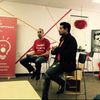The statement made by Ahmad Ashkar, founder and CEO of the Hult Prize Foundation, that "charity alone is not enough," is no longer as controversial as it was in 2009. Today, this idea has become mainstream, as organizations increasingly deploy capital to the world's poorest through sustainable businesses, instead of traditional altruistic charity.
The practice of creating revenue-generating business models aimed to facilitate long-term empowerment of the bottom of the pyramid (BOP) transforms the world's poorest from "beneficiaries" into paying customers, and actors in their own upward mobility. New and innovative financing structures are emerging, and a host of global players are using a variety of models to more efficiently and equitably allocate capital, spurred, in part, by the success of early movers like Mohammed Yunus' Grameen initiative.
Platforms like Kiva are offering individuals the opportunity to lend to small entrepreneurs; VentureFin, based out of the UAE, is connecting funders to early stage opportunities through an equity-based crowd-funding platform; and boards at major US foundations like Heifer, Western Union, and Pincus are actively discussing the possibility of using equity-based investing as a means to meeting their charitable objectives.
Traditionally, the primary financial vehicles used to channel investment to early stage entrepreneurs seeking impact as well as profit have mostly focused on debt (whether backed by physical assets or receivables; traditional or convertible), and equity. At the Hult Prize, we challenge and train students to question the status quo, and develop innovative business and funding models that disrupt existing paradigms.
It is no surprise, then, that IMPCT, the 2015 $1m winner of the annual Hult Prize, sought to develop a new financing mechanism to suit their business. IMPCT enables the hundreds of thousands of young female entrepreneurs running small, informal daycares in their homes to invest in safer spaces, build skills and know-how, acquire educational tools and toys, and share their experiences and success with the community, thereby expanding their business and increasing income.
This requires an initial deployment of capital to the local entrepreneur, which the team believed could be provided by wealthier individuals in the developed world. To achieve this, they identified upfront the following four needs:
1.Enable a return of capital within a reasonable time frame (exit)
2.Connect payments to the entrepreneur's ability to pay (not fixed)
3.Match returns to the risk profile in frontier markets
4.Align investor and entrepreneur incentives and interests
The team quickly realized that relying on debt financing in any its common forms could place an undue burden on early-stage entrepreneurs, particularly in cases where they are generating no or insufficient operating income to meet the fixed repayment schedule. Even factoring in grace periods wouldn't account for the potentially volatile nature of cash flow generation in small, early-stage startups. Further, revenue-based debt structures aren't aligned with a company's true ability to pay, as they're usually tied to revenue before expenses.
While equity structures would provide greater flexibility in terms of outgoing payments, they fail to provide well-defined exit opportunities for smaller scale startups who don't have access to capital markets and liquidity, tying funders in for undefined periods of time. In addition, cross-border equity investments in BOP startups come with a host of legal and regulatory challenges.
Over the course of Hult Prize's 2015 Incubation program, which runs for seven weeks in Boston every year, the team was able to meet with leading academics, attorneys, and investors to explore potential structures that could meet their needs. Working with Kristin Gerber at Mintz Levin, leading economist and professor Dr. Omar Fisher, and their assigned mentor, technology guru Scott Weiner from NeuEon, they designed the basic requirements and potential terms for an instrument they could use to fund young women entrepreneurs in emerging markets.
Through a rigorous research process, they came upon an innovative and new financing mechanism developed at Santa Clara University called Demand Dividend that meets their objectives. It provides the ability to tie payments to operating cash flow, allows for a grace period of 10 to 24 months, enables the up front negotiation of a pre-agreed payoff amount which is a multiple of the initial investment, and aligns investor and entrepreneur incentives.
IMPCT, like any great entrepreneurial team, has been willing to defy conventional wisdom to create something better and bolder, and they found in Demand Dividend a ready answer that helped save valuable time and resources. While no single structure can mitigate all the risks of investing in early-stage emerging market startups serving the BOP, Demand Dividend is a compelling alternative that should be part of the social entrepreneur's toolkit.
